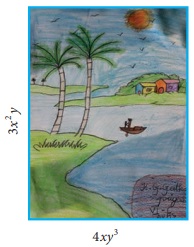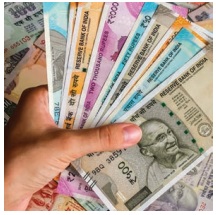Algebra | Chapter 3 | 8th Maths - Multiplication of Algebraic Expressions | 8th Maths : Chapter 3 : Algebra
Chapter: 8th Maths : Chapter 3 : Algebra
Multiplication of Algebraic Expressions
Multiplication
of Algebraic Expressions
While doing
the product of algebraic expressions, we should follow the steps given below.
Step 1: Multiply the signs of the
terms. That is, the product of two like signs are positive and the product of two unlike signs are negative.

Step 2: Multiply the corresponding
co-efficients of the terms.
Step 3: Multiply the variable factors
by using laws of exponents.
If ‘x’ is a variable and m, n are positive integers
then,
x m × xn = xm +n
For
example, x3 ×
x4 =
x3 +4 = x7
Think
Every algebraic expression is a polynomial. Is this statement true?
Why?
Solution:
No, This statement is not true. Because Polynomials contain only
whole numbers as the powers of their variables. But an algebraic expression may
contains fractions and negative powers on their variables.
Eg. 2y2 + 5y−1 − 3 is a an
algebraic expression. But not a polynomial.
A polynomial is a special kind of algebraic expression. The difference
between an algebraic expression and a polynomial is,
Algebraic Expression
May contains whole numbers, fractions, negative numbers as the power
of their variables.
Example: 4x3/2
− 3x + 9
2 y2 + 5/y − 3 , 3x2 − 4x + 1
Polynomial
contains only whole numbers as the power of their variables.
Example: 4x 2 − 3x + 9
2 y 6 + 5y3
− 3
Note
Product of two terms is represented by the symbols ( ), dot (.) or
× .
For example,
multiplying 4x2
and xy can be written in any one of the
following ways.

1. Multiplication
of two or more monomials
Consider
that, Geetha buys 3 pens each @ ₹5, how much she has to pay to the shopkeeper?
Geetha has
to pay to the shopkeeper = 3 × ₹5
= ₹15

If there
are ‘x’ pens and the cost of each pen
is ₹
‘y’, then the cost of (3x2 ) pens bought by Geetha @ ₹
5y
@ - at the rate of

= (3x 2 ) × 5y
= (3 × 5)(x 2 × y)
= ₹
15x2y
Example 3.1
If the length
and breadth of a rectangular painting are 4xy3
and 3x 2 y . Find its area.

Solution:
Area of the
rectangular painting, A =
(l × b)
sq.units
= (4xy3 ) × (3x 2 y)
= (4 × 3)(x × x2 )( y 3 × y)
A = 12x 3 y4 sq.units
Example 3.2
Find the
product of 2x 2 y2 , 3 y 2z and – z 2 x3
Solution:
We have,
(2x 2 y2 ) × (3 y 2 z) ×
(−z 2 x3
)
= ( +) × ( +) × ( −)(2 × 3 ×1)(x 2 × x3
)( y 2 ×
y2 )(z × z2 )
= −6x 5 y4z3
Try these
Find the product of
(i) 3ab2 , −2a2b3
(ii) 4xy, 5 y2 x,(−x2 )
(iii) 2m, −5n, −3p
Solution:
(i) (3ab2)
× (−2a2b3) = (+) × (−) × (3 × 2) × (a × a2) × (b2
× b3) = − 6a3 b5
(ii) (4xy) ×
(5y2x) × (−x2) = (+) × (+) × (−) × (4 × 5 × 1) × (x × x × x2)
× (y × y2)
= −20 x4y3
(iii) (2m) ×
(−5n) × (−3p) = (+) × (−) × (−) × (2 × 5 × 3)
× m × n × p
= + 30 mnp = 30 mnp
2. Multiplication
of a polynomial by a monomial
If there
are ‘a’ shops and each shop has ‘x’ apples in 8 baskets and ‘y’ oranges in 3 baskets and ‘z’ bananas in 5 baskets, then the total number
of apples, oranges and bananas are

= a × (8x + 3y + 5z)
= a(8x) + a(3y) + a(5z)
(using distributive
law).
= 8ax
+
3ay + 5az
monomial × monomial = monomial
binomial × monomial = binomial
binomial × binomial = binomial/polynomial
polynomial × monomial = polynomial
Note
Distributive law
If a is a constant, x and y are variables then 
a(x + y) = ax + ay
For example, 5(x + y) = 5x + 5 y
Think
Why 3+(4x–7y) ≠ 12x−21y ?
Solution:
Addition and multiplication are different 3 + (4x − 7y)
= 3 + 4x − 7y
We can add only like terms.
Example 3.3
Multiply
3x 2 y and (2x 3 y3 −
5x 2 y + 9xy)
Solution:
Now, (3x 2 y) × (2x 3 y3
−
5x 2 y + 9xy)

= 3x 2 y(2x 3 y3 ) −
3x 2 y (5x 2 y ) + 3x 2 y(9xy)
multiplying
each term of the polynomial by the monomial
= (3 ×
2)(x 2 ×
x3 )( y × y3 ) −
(3 ×
5)(x 2 ×
x2 )( y × y) +
(3 ×
9)(x 2 ×
x)( y × y)
= 6x5y4 − 15x4 y2
+
27x 3 y2
Example 3.4
Ram deposited
‘x’ number of ₹2000
notes, ‘y’ number of ₹500
notes, ‘z’ number of ₹100
notes in a bank and Velan deposited ‘3xy’
times of amount of what Ram had deposited. How much amount did Velan deposit in
the bank?
Solution:
Amount deposited
by Ram
= ( x ×₹ 2000 + y ×₹ 500 + z ×₹100)
= ₹( 2000x + 500 y +100z )

Amount deposited
by Velan =
3xy times ×
Amount deposited by Ram
= ₹ 3xy × (2000x + 500 y +
100z)
= (3 × 2000)(x × x ×
y ) + (3 × 500)(x × y ×
y ) + (3 ×100)(x × y ×
z)
= ₹ (6000x 2 y + 1500xy 2 + 300xyz)
Try these
Multiply
(i) (5 x2 +
7x – 3) by –4x2
(ii) (10x – 7y + 5z)
by 6xyz
(ii) (ab+3bc –5ca)
by 3a2bc
(iv) (4m2 –
3m + 7) by –5m3
Solution:
(i) (5x2 + 7x − 3) by – 4x2

(5x2 + 7x − 3) × (– 4x2)
= 5x2 (− 4x2) + 7x (− 4x2)
− 3(− 4x2)
= − 20 x4 − 28x3 + 12x2
(ii) (10x −7y + 5z) by 6xyz

(10x −7y + 5z) × 6xyz = 6xyz
(10x − 7y + 5z) [∵ Multiplication is commutative]
= 6xyz(10x) + 6xyz(−7y) + 6xyz(5z)
= (6 × 10) (x × x × y × z) + (6 × −7)
+ (x × y × y × z ) + (6 × 5)(x × y × z
× z)
= 60x2yz + (−42xy2z)
+ 30xyz2
= 60x2yz − 42xy2z
+ 30xyz2
(iii) (ab +
3bc − 5ca) by 3a2 bc
(ab + 3bc −
5ca) × (3a2bc) = ab(3a2bc)
+ 3bc (3a2bc) − 5ca (3a2bc)
= 3a2b2c + 9a2b2c2
− 15a3bc2
(iv) (4m2
− 3m + 7) by − 5m3
(4m2 − 3m
+ 7) × (− 5m3) = 4m2 (− 5m3)
− (3m) (− 5m3) + 7(− 5m3)
= − 20m5 + 15m4 − 35m3
3. Multiplication
of two binomials
Consider
that a rectangular flower bed whose length is decreased by 5 units from the original length and whose
breadth is increased by 3 units to the
original breadth. What is the area of the rectangular flower bed?

Area of the
rectangle = l ×
b
Here, area
of the rectangular flower bed A =
(l − 5) × (b + 3) sq.units
How do we
multiply this?
Now, let us learn how to multiply two binomials
If (x + y)
and ( p +
q) are two binomials, we can find their
product as given below,

So, the above
area of the rectangle = (l − 5) × (b + 3)
(By horizontal
distributive approach) = l
(b + 3) − 5(b + 3)
A = (lb + 3l
− 5b −15) sq.u

Let us consider
one more example. Consider the given figure , In the square OABC,
OA= 4 units ; OC =4 units
The area
of the square OABC = 4 × 4
A = 16 sq.units
If the sides
of the square are increased by ‘x’ units and
‘y’ units respectively,then we get the rectangle ODEF whose sides are OD=(4+x) units
and OF=(4+y) units.

Now, the area of the rectangle ODEF = (4+x) (4+y) (by FOIL approach)

A = 16+ 4y
+ 4x + xy sq. units.
(all are unlike terms andso, we can’t add)
Example 3.5
Multiply
(2x + 5 y) and (3x −
4 y)
Solution:
By horizontal distributive approach,
(2x + 5y) (3x − 4 y) = 2 x (x
− 4 y) + 5 y ( x − 4 y)

= 6x2 − 8xy + 15xy − 20 y2
=
6x2 +
7xy − 20 y2 (simplify the like terms)

Try these
Multiply
(i) (a − 5) and (a + 4)
(ii) (a + b) and (a − b)
(iii) (m4 +
n4 ) and (m − n)
(iv) (2x + 3)(x + 4)
(v) (3x + 7)( x −5)
(vi) (x − 2)(6x − 3)
Solution:
(i) (a − 5) and (a + 4)
(a − 5) (a
+ 4) = a(a + 4) − 5(a + 4)
= (a × a) + (a × 4) + (−5 × a) + (−5
× 4)
= a2 + 4a − 5a − 20 = a2
− a − 20
(ii) (a + b) and (a − b)
(a + b) (a − b)
= a(a − b) + b(a − b)
= (a × a) + (a × −b) + (b × a
) + b(− b)
= a2 − ab + ab − b2
= a2 − b2
(iii) (m4 + n4) and (m −
n)
(m4 + n4) (m − n) = m4
(m − n) + n4 (m − n)
= (m4 × m) + (m4 × (−
n)) + (n4 × m) + (n4 × (−n))
= m5 − m4 n + mn4
– n5
(iv) (2x + 3) (x + 4)
(2x + 3) (x
+ 4) = 2x(x + 4) + 3(x
+ 4)
= (2x2 × x) + (2x × 4) + (3 × x)
+ (3 × 4)
= 2x2 + 8x + 3x + 12 = 2x2
+ 11x + 12
(v) (3x + 7) (x − 5)
(3x + 7) (x
− 5) = x(3x + 7) − 5(3x
+ 7)
= (x × 3x) + (x × 7) + (−5 × 3x) + (−5
× 7)
= 3x2 + 7x − 15x − 35
= 3x2 − 8x – 35
(vi) (x − 2) (6x − 3)
(x − 2) (6x
− 3) = x(6x − 3) − 2(6x
− 3)
= (x × 6x) + (x × (−3) − (2 × 6x) − (2
× 3)
= 6x2 − 3x − 12x + 6
= 6x2 − 15x + 6
Think
(i) In 3x2 (x4–7x3+2), what is the highest power
in the expression?
Solution:
3x2 (x4 − 7x3
+ 2) = (3x2) (x4)
+ 3x2 (− 7x3) + (3x2)2
= 3x2 −
21x5 + 6x2
Highest power is 6 in x6.
(ii) Is –5y2
+2y–6 = –(5y2 +2y–6)? If not,
correct the mistake.
Solution:
No, – 5y2 + 2y – 6 = − (5y2
− 2y + 6 )